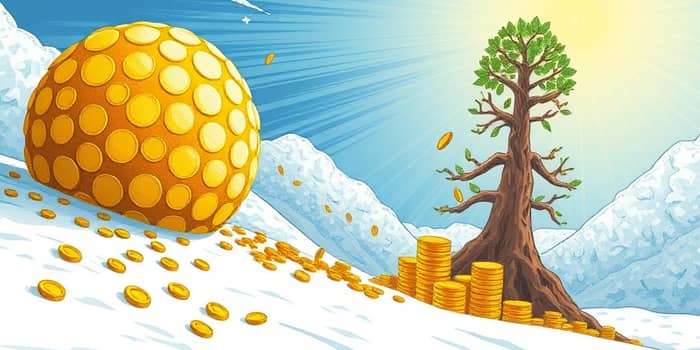Compound interest is often hailed as the financial world’s most compelling force, one that quietly transforms modest investments into substantial fortunes over time. By understanding its principles and harnessing its momentum, anyone can unlock a path to lasting prosperity.
Imagine watching a tiny snowball gain mass as it rolls downhill, growing larger with every revolution. That vivid image captures the essence of compound interest, a mechanism that rewards patience, consistency, and foresight with rewards that can exceed your wildest expectations.
Definition and Core Concept
At its essence, compound interest involves interest calculated on both the principal and any previously earned interest. Each compounding period adds a fresh layer of earnings, creating a powerful snowball effect over time.
Unlike simple interest, which applies only to the initial sum, compound interest accelerates growth as your wealth begins to self-propel. This dynamic process has earned Albert Einstein’s admiration—he reportedly called it the “eighth wonder of the world.”
Mathematical Formula
The fundamental compound interest formula is:
Compound interest = P (1 + i)n – P, where P is the principal, i is the annual interest rate (decimal), and n is the number of compounding periods.
An alternate expression calculates the future value directly as FV = P (1 + r/n)n t. In this version, r represents the nominal annual rate, n the number of compounding intervals per year, and t the total years invested. The exponent n·t captures the cumulative effect of each compounding event.
Compounding Frequency and Its Impact
Compounding intervals can significantly influence final returns. At a 5% nominal rate, the effective annual yield varies by frequency:
This comparison shows that more frequent compounding leads to greater growth even if the stated rate remains unchanged. When selecting savings accounts or investments, consider how often interest is credited.
Practical Example for Building Wealth
Suppose you invest $10,000 at a 5% annual rate, compounded once per year. The results illustrate how quickly small gains build momentum:
- End of Year 1: $10,000 + $500 interest = $10,500
- End of Year 2: $10,500 + $525 interest = $11,025
Watch how those yearly interest payments jump from $500 to $525. Over decades, this pattern accelerates, turning modest sums into life-changing balances.
Detailed Calculation Example
For a more thorough illustration, imagine $10,000 invested at 8% interest, compounded monthly, for 5 years. First calculate FV = 10,000 (1 + 0.08/12)60. Evaluating the factor (1.0066667)60 yields a future value of $14,898.46. In this scenario, your total interest earned equals $4,898.46, underscoring how small monthly additions add up dramatically.
The Rule of 72
The Rule of 72 provides a quick estimate of how long it takes for an investment to double. Simply divide 72 by the annual interest rate. For example, at 4% interest, your money will double in approximately 18 years (72 ÷ 4 = 18).
While the Rule of 72 is an approximation and ignores fees or fluctuating rates, it offers an intuitive glimpse into time’s role in compounding. Use precise calculators for exact planning.
Real-Life Success Stories
Warren’s Early Advantage
Warren embarked on his investing journey in his early twenties, dedicating a small portion of each paycheck to a diversified portfolio. As decades passed, the interplay of market growth and compounding interest allowed his savings to flourish, ultimately granting him financial independence far sooner than he imagined.
Charlie’s Inheritance Transformation
At age 22, Charlie invested a $10,000 inheritance in a low-cost index fund. He resisted the temptation to withdraw funds, letting compound interest and market returns work in tandem. By age 62, that original gift had swelled to nearly $150,000—a testament to earning interest on your interest.
Compound Interest Can Also Work Against You
Debt can mirror the effects of compounding but in reverse, magnifying what you owe:
Brandon’s Student Loan Challenge
With $50,000 in student loans at 7% interest, Brandon made only the minimum $200 monthly payments. Since his payments fell short of covering new interest charges, his balance climbed to $65,866 after ten years, despite consistent payments.
Amanda’s Credit Card Trap
Amanda used her credit card for a $10,000 vacation at a 25% interest rate. Making $150 monthly payments, she found her balance increasing to $10,786 after one year, illustrating how unpaid interest compounds against you.
Key Factors Affecting Compound Interest
- Initial principal amount: Larger starting capital builds more base for growth.
- Interest rate: higher rates lead to faster growth and larger gains.
- Time: time is the most powerful factor—longer horizons amplify compounding effects.
- Compounding frequency: More intervals mean more interest-on-interest events.
- Additional contributions: regular contributions accelerate your results and broaden your compounding base.
Strategies for Maximizing Compound Interest
- Start early to leverage every extra day of compounding potential.
- Increase your initial investment whenever possible.
- Make consistent contributions, even small ones.
- Reinvest dividends and interest to keep earnings working.
- Choose investments that balance reasonable returns with acceptable risk.
- Be patient: compounding works best over long timeframes.
Applications of Compound Interest
Compound interest forms the backbone of many financial vehicles, including retirement plans like 401(k)s and IRAs, high-yield savings accounts, certificates of deposit, dividend reinvestment plans, and taxable investment portfolios. By strategically selecting vehicles that match your goals, you can tailor a compounding strategy that aligns with your risk tolerance and time horizon.
Whether you aim for early retirement, a comfortable nest egg, or financial independence, understanding and applying compound interest can transform your aspirations into reality. The key lies in discipline, education, and a long-term mindset.
Conclusion
Compound interest stands as one of the most powerful tools in personal finance. From small beginnings, it can generate wealth that far exceeds initial expectations, provided you remain patient and consistent. Every dollar you invest today carries the potential to multiply itself into something far greater.
Begin your journey now. Set clear goals, choose suitable accounts, and make regular contributions. Over time, the magic of compound interest will reward your diligence, turning your financial dreams into tangible achievements.
References
- https://www.investopedia.com/terms/c/compoundinterest.asp
- https://byjus.com/maths/compound-interest/
- https://www.youtube.com/watch?v=ElVOYsNzwkE
- https://www.calculatorsoup.com/calculators/financial/compound-interest-calculator.php
- https://ca.indeed.com/career-advice/career-development/compound-interest-calculation
- https://www.nasaa.org/investor-education/young-adult-money-mission/compound-interest-2/
- https://www.carsonwealth.com/insights/blog/compounding-wealth-and-wisdom/
- https://www.pnc.com/insights/personal-finance/save/what-is-compound-interest.html










